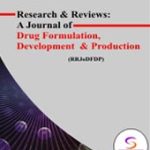
Satish kumar Yadav

Vikash Yadav

Mohd. Wasiullah

Piyush Yadav

Mohammad Adham
- Associate Professor Department of Pharmacy, Prasad Institute of Technology, Jaunpur Uttar Pradesh India
- Professor Department of Pharmacy, Prasad Institute of Technology, Jaunpur Uttar Pradesh India
- Principal Department of Pharmacy, Prasad Institute of Technology, Jaunpur Uttar Pradesh India
- Academic Head Department of Pharmacy, Prasad Institute of Technology, Jaunpur Uttar Pradesh India
- Research Scholar Department of Pharmacy, Prasad Institute of Technology, Jaunpur Uttar Pradesh India
Abstract
Computer-Aided Drug Design (CADD) has revolutionized the drug discovery process by providing efficient and cost-effective methods for identifying potential drug candidates. Within CADD, ligandbased virtual screening techniques play a pivotal role in the early stages of drug discovery. This review provides a comprehensive overview of ligand-based drug virtual screening, focusing on its principles, applications, challenges, and future directions. Fundamentals of ligand-based virtual screening, including pharmacophore-based methods, similarity searching, and machine learning approaches, are elucidated. Applications of ligand-based virtual screening in drug repurposing, lead optimization, and target identification are discussed, alongside case studies highlighting its success in identifying novel drug candidates. Furthermore, the review compares ligand-based virtual screening with structurebased approaches, emphasizing their complementary nature and integration in CADD workflows. Challenges such as data availability, model accuracy, and computational resources are addressed, with recommendations provided for best practices in virtual screening studies.
Keywords: Virtual screening; deep learning; drug discovery; drug-target interaction; drug-target affinity.
[This article belongs to Research & Reviews: A Journal of Drug Formulation, Development and Production(rrjodfdp)]
References
1. D. E. Salazar, G. Gormley. Modern drug discovery and development, Cts-Clin Transl. Sci. (2017) 719-743. Academic Press.
2. N. Berdigaliyev, M. Aljofan. An overview of drug discovery and development, Future Med. Chem. 12 (10) (2020) 939-947.
3. Butkiewicz M, Wang Y, Bryant SH, Lowe Jr EW, Weaver DC, Meiler J. High-throughput screening assay datasets from the pubchem database. Chemical informatics (Wilmington, Del.). 2017;3(1).
4. T. Scior, A. Bender, G. Tresadern, et al., Recognizing pitfalls in virtual screening: A critical review, J. Chem. Inf. Model. 52 (4) (2012) 867-881.
5. H. Wang, J. J. Tang, Y. J. Ding, et al., Exploring associations of non-coding RNAs in human diseases via three-matrix factorization with hypergraph-regular terms on center kernel alignment, Brief. Bioinform. 22 (5) (2021) bbaa409.
6. Ezzat A, Wu M, Li X L, et al. Computational prediction of drug–target interactions using chemogenomic approaches: An empirical survey. Briefings in bioinformatics, 2019, 20(4): 1337-1357.
7. Bagherian M, Sabeti E, Wang K, et al. Machine learning approaches and databases for prediction of drug–target interaction: A survey paper. Briefings in bioinformatics, 2021, 22(1): 247-269.
8. Dhakal A, McKay C, Tanner J J, et al. Artificial intelligence in the prediction of protein–ligand interactions: Recent advances and future directions. Briefings in Bioinformatics, 2022, 23(1): bbab476.
9. Agamah F E, Mazandu G K, Hassan R, et al. Computational/in silico methods in drug target and lead prediction. Briefings in bioinformatics, 2020, 21(5): 1663-1675.
10. Abbasi K, Razzaghi P, Poso A, et al. Deep learning in drug target interaction prediction: Current and future perspectives. Current Medicinal Chemistry, 2021, 28(11): 2100-2113
11. Hughes, J.P., Rees, S.S., Kalindjian, S.B., Philpott, K.L.: Principles of early drug discovery. Br. J. Pharmacol. 162, 1239–1249 (2011)
12. Carnero A. High throughput screening in drug discovery. Clinical and Translational Oncology. 2006 Jul;8:482-90.
13. Introduction to pharmacokinetics and pharmacodynamics. In: Concepts in Clinical Pharmacokinetics, pp. 1–18. https://www.ashp.org/-/media/store%20files/p2418-sample-chapter-1.pdf
14. Guedes, R., Serra, P., Salvador, J., Guedes, R.: Computational approaches for the discovery of human proteasome inhibitors: an overview. Molecules 21, 1–27 (2016)
15. Petterson, I., Balle, T., Liljefors, T.: Ligand based drug design. In: Textbook of Drug Design and Discovery, pp. 43–57 (2010)
16. Kubinyi H. Quantitative structure–activity relationships. 7. The bilinear model, a new model for nonlinear dependence of biological activity on hydrophobic character. J Med Chem. 1977 May;20(5):625-9. doi: 10.1021/jm00215a002
17. Polanski, J.: Receptor dependent multidimensional QSAR for modeling drug – receptor interactions. Curr. Med. Chem. 16 (25), 3243–3257 (2009)
18. Sippl, W.: 3D-QSAR – Applications, recent advances, and limitations. In: Recent Advances in QSAR Studies, pp. 103–126 (2010)
19. Yun T, Weiliang Z, Kaixian C, Hualiang J; New technologies in computer-aided drug design: Toward target identification and new chemical entity discovery; Drug discovery today: technologies; 2006; 3(3); 307-313.
20. Pranita PK, Madhavi MM, Rishikesh VA, Rajesh JO, Sandip SK; Computer-aided drug design: an innovative tool for modeling; Journal of medicinal chemistry; 2012; 2; 139-148.
21. Pugazhendhi D, Umamaheswari TS; In silico methods in drug discovery–a review; International journal of advanced research in computer science and software engineering; 2013; 3(5); 680-683.
22. http://www.slideshare.net/adammbbs/structure- based-drug-design-48389641/12; Structure-based drug design (Docking and de novo drug design); Authored by Adam Shahul Hameed; Anna University Chennai; Available online from 2015.
23. Silvana G; Computer-based methods of inhibitor prediction; Intech open science and open minds; 2013; Chapter 3; 73-90.
| Volume | 11 |
| Issue | 02 |
| Received | May 10, 2024 |
| Accepted | May 17, 2024 |
| Published | July 10, 2024 |
function myFunction2() {
var x = document.getElementById(“browsefigure”);
if (x.style.display === “block”) {
x.style.display = “none”;
}
else { x.style.display = “Block”; }
}
document.querySelector(“.prevBtn”).addEventListener(“click”, () => {
changeSlides(-1);
});
document.querySelector(“.nextBtn”).addEventListener(“click”, () => {
changeSlides(1);
});
var slideIndex = 1;
showSlides(slideIndex);
function changeSlides(n) {
showSlides((slideIndex += n));
}
function currentSlide(n) {
showSlides((slideIndex = n));
}
function showSlides(n) {
var i;
var slides = document.getElementsByClassName(“Slide”);
var dots = document.getElementsByClassName(“Navdot”);
if (n > slides.length) { slideIndex = 1; }
if (n (item.style.display = “none”));
Array.from(dots).forEach(
item => (item.className = item.className.replace(” selected”, “”))
);
slides[slideIndex – 1].style.display = “block”;
dots[slideIndex – 1].className += ” selected”;
}


